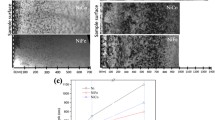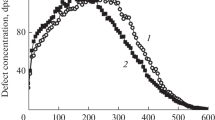Abstract
In previous Perturbed-Angular-Correlation (PAC) studies of the γ-γ emission of 111In probe nuclei in cold-worked or particle-irradiated nickel, it has been found that thermal annealing in the temperature regime of recovery stage III leads to the formation of so-called C-defects (Cubic defects). This is indicated by the occurrence of a new frequency of about 80 Mrad/s, in addition to the frequency (≈200 Mrad/s) that is due to 111In on substitutional sites. Obviously, the C-defects are complexes consisting of 111In and the intrinsic point-defect species that migrates freely in recovery stage III. Therefore, they have played an important rôle in the long-standing controversy on whether the recovery-stage-III defects are vacancies (one-interstitial model) or self-interstitials (two-interstitial model). The present paper reports on a novel experimental effort to reveal the nature of the C-defects by combining PAC studies on nickel samples differently pretreated in a systematic way, investigations of the Extended X-ray Absorption Fine Structure (EXAFS) on In-doped nickel, and measurements of the decay rate of 111In nuclei in the Electron-Capture-Induced Decay (ECID). On the basis of the results of these experiments it is concluded that the defects trapped by substitutional 111In atoms (Ins) in recovery stage III are self-interstitials (I), as expected according to the two-interstitial model. Moreover, there is evidence that the C-defects are In interstitials on tetrahedral sites (Ini) that form exclusively in the vicinity of the specimen surface from Ins − I pairs via the reaction Ins+I → Ini.
Similar content being viewed by others
References
H. Frauenfelder, R.M. Steffen: In Perturbed Angular Correlations, ed. by E. Karlsson (North-Holland, Amsterdam 1964) p. 3
H. Frauenfelder, R.M. Steffen: In Alpha-, Beta-, and Gamma- Ray Spectroscopy, ed. by K. Siegbahn, Vol. 2 (North-Holland, Amsterdam 1965) p. 997
E. Recknagel, G. Schatz, T. Wichert: In Hyperfine Interactions of Radioactive Nuclei, ed. by J. Christiansen, Topics Curr. Phys., Vol. 31 (Springer, Berlin, Heidelberg 1983) p. 133
G. Schatz, A. Weidinger: Nukleare Festkörperphysik (Teubner, Stuttgart 1985)
C. Hohenemser, A.R. Arends, H. de Waard, H.G. Devare, F. Pleiter, S.A. Drentje: Hyperfine Interact. 3, 297 (1977)
C. Allard, G.S. Collins, C. Hohenemser: Hyperfine Interact. 15/16, 387 (1983)
G.S. Collins, R.B. Schuhmann: Hyperfine Interact. 15/16, 391 (1983)
C. Allard, G.S. Collins, C. Hohenemser: Phys. Rev. B 32, 4839 (1985)
J.R. Fransens, F. Pleiter, J. Meinders: Solid State Commun. 71, 1155 (1989)
A. Seeger, H. Kronmüller: Mater. Sci. Forum 15–18, 65 (1987)
J. Voigt, X.L. Ding, R. Fink, G. Krausch, B. Luckscheiter, R. Platzer, V. Wöhrmann, R. Wesche, G. Schatz: In Nukleare Festkörperphysik, ed. by E. Recknagel, G. Schatz, Jahresbericht 1989 (Universität Konstanz, Konstanz 1989) p. 18
W. Frank, A. Seeger: Solid State Commun. 68, 495 (1988)
W. Schilling, P. Ehrhart, K. Sonnenberg: In Fundamental Aspects of Radiation Damage in Metals, ed. by M.T. Robinson, F.W. Young, Jr., Vol. 1, (USERDA, CONF-751006-P1, Gatlinburg, TN 1976) p. 470
A. Seeger: In Fundamental Aspects of Radiation Damage in Metals, ed. by M.T. Robinson, F.W. Young, Jr., Vol. 1, (USERDA, CONF-751006-P1, Gatlinburg, TN 1976) p. 493
H.G. van Bueren: Z. Metallkde. 46, 272 (1955)
W. Bauer, J.W. DeFord, J.S. Koehler, J.W. Kauffman: Phys. Rev. 128, 1497 (1962)
A. Seeger: J. Phys. Soc. Jpn. 18, Suppl. III, 260 (1963)
W. Schilling, K. Sonnenberg, H.-J. Dibbert: Radiat. Effects 16, 57 (1972)
M. Nakagawa, K. Böning, P. Rosner, G. Vogl: Phys. Rev. B 16, 5285 (1977)
A. Seeger: J. Phys. F 3, 248 (1973)
A. Seeger: Cryst. Lattice Defects 4, 221 (1973)
B. Besold, E. Danielsen, H. Hofsäss, G. Lindner, J.W. Petersen, E. Recknagel, M. Sondergaard, G. Weyer, S. Winter: Mater. Sci. Forum 15–18, 665 (1987)
G. Lindner, H. Hofsäss, S. Winter, S.G. Jahn, U. Wahl, W. Pfeiffer, E. Recknagel: In Nukleare Festkörperphysik, ed. by E. Recknagel, G. Schatz, Jahresbericht 1987 (Universität Konstanz, Konstanz 1987) p. 34
G. Dlubek, R. Krause, O. Brümmer, Z. Michno, T. Gorecki: J. Phys. F 17, 1333 (1987)
D. Sayers, E.A. Stern, F. Lytle: Phys. Rev. Lett. 27, 1204 (1971)
E.A. Stern: Phys. Rev. B 10, 3027 (1974)
D. Sayers, E.A. Stern, F. Lytle: Phys. Rev. B 11, 4825 (1975); Phys. Rev. B 11, 4836 (1975)
J. Pendry: In EXAFS and Near Edge Structure, ed. by A. Bianconi, L. Incoccia, S. Stipcich, Springer Ser. Chem. Phys., Vol. 27 (Springer, Berlin, Heidelberg 1983) p. 4
E.A. Stern: In X-Ray Absorption Principles, Applications, Techniques of EXAFS, SEXAFS and XANES, ed. by D. Koningsberger, R. Prins (Wiley, New York 1988) p. 3
B. Teo: EXAFS: Basic Principles and Data Analysis, Inorg. Chem. Concepts, Vol. 9 (Springer, Berlin, Heidelberg 1986)
P. Marmier, E. Sheldon: Physics of Nuclei and Particles, Vol. 1 (Academic, New York 1969)
J. Kraushaar, E. Wilson, K. Bainbridge: Phys. Rev. 90, 610 (1953)
B. Aspacher: EXAFS-, PAC-, Energieverschiebungs- und Lebensdauermessungen an indiumdoriertem Nickel. Dissertation, Universität Stuttgart, Stuttgart (1991)
B. Aspacher: Untersuchung atomarer Fehlstellen mit gestörter Winkelkorrelation in Metallen. Diploma Thesis, Universität Stuttgart, Stuttgart (1988)
G. Gutekunst: Gestörte Winkelkorrelation an Legierungen. Diploma Thesis, Universität Stuttgart, Stuttgart (1990)
M. Lederer, V. Shiley: Table of Isotopes (Wiley, New York 1978)
A. Krolzig, G. Materlik, M. Swars, J. Zegenhagen: Nucl. Instrum. Methods 219, 430 (1984)
B. Lengeler: Private communication
D. Williamson: In Mössbauer Isomer Shifts, ed. by G. Shenoy, F. Wagner (North-Holland, Amsterdam 1978) p. 317
B. Aspacher, K. Maier: To be published
K.-H. Robrock: Mater. Sci. Forum 15–18, 537 (1987)
L. Niesen: Hyperfine Interact. 79, 701 (1993)
Author information
Authors and Affiliations
Rights and permissions
About this article
Cite this article
Aspacher, B., Frank, W., Kizler, P. et al. The nature of the C-defects in nickel and their rôle in the interpretation of radiation damage in metals. Appl. Phys. A 59, 339–348 (1994). https://doi.org/10.1007/BF00331710
Received:
Accepted:
Issue Date:
DOI: https://doi.org/10.1007/BF00331710




